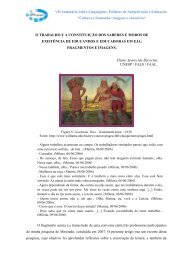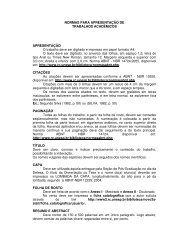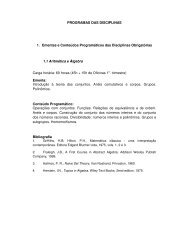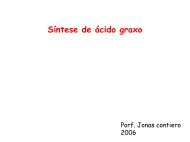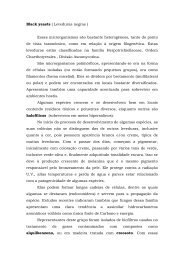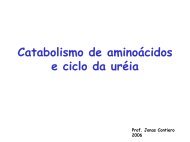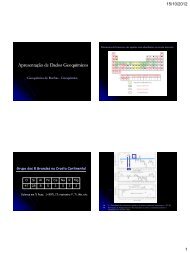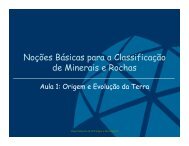Diet and Spatial Pattern of Foraging in Ectatomma opaciventre ...
Diet and Spatial Pattern of Foraging in Ectatomma opaciventre ...
Diet and Spatial Pattern of Foraging in Ectatomma opaciventre ...
Create successful ePaper yourself
Turn your PDF publications into a flip-book with our unique Google optimized e-Paper software.
T<strong>of</strong>olo, V.C. et al. — <strong>Spatial</strong> <strong>Pattern</strong> <strong>of</strong> <strong>Forag<strong>in</strong>g</strong> <strong>in</strong> E. <strong>opaciventre</strong><br />
recorded site fidelity <strong>in</strong> the area explored by workers <strong>of</strong> E. <strong>opaciventre</strong>, that is,<br />
the forager tended to have a preference for a specific forag<strong>in</strong>g pathway, which<br />
made it a specialist <strong>in</strong> the <strong>in</strong>dividual exploration <strong>of</strong> sub-areas, becom<strong>in</strong>g able<br />
to return to the nest quickly. The same pattern was observed <strong>in</strong> Pachycondyla<br />
apicalis (Fresneau 1985; Deneubourg et al. 1987), D. quadriceps (Azevedo<br />
2009), D. gigantea (Fourcassié & Oliveira 2002), Cataglyphis exhibits, <strong>and</strong><br />
C. bicolor (Buchkremer & Re<strong>in</strong>old 2008).<br />
Fresneau (1985) proposed a simple mechanism to expla<strong>in</strong> such fidelity:<br />
dur<strong>in</strong>g the first trip, new foragers select a portion <strong>of</strong> the forag<strong>in</strong>g area, which is<br />
confirmed by the capture <strong>of</strong> the first prey. Through a simple learn<strong>in</strong>g process,<br />
the ants keep search<strong>in</strong>g <strong>in</strong> the same area dur<strong>in</strong>g the follow<strong>in</strong>g trips. If foragers<br />
from the same colony meet <strong>in</strong> an overlapp<strong>in</strong>g area, both make <strong>in</strong>tense antennal<br />
contact before leav<strong>in</strong>g for different pathways. This mechanism <strong>in</strong>duces the<br />
forager to decrease search for food <strong>in</strong> areas used by other foragers, <strong>in</strong>creas<strong>in</strong>g<br />
the effectiveness <strong>of</strong> forag<strong>in</strong>g on a colony-basis. Gordon (1995) believes that<br />
follow<strong>in</strong>g the same direction enables foragers to explore a specific fan-shaped<br />
area, so as to deplete the resources <strong>in</strong> one direction before mov<strong>in</strong>g to the adjacent<br />
area. This way, when they return to the <strong>in</strong>itial position, the resources<br />
are available aga<strong>in</strong>. This was also observed <strong>in</strong> P. striata (Medeiros & Oliveira<br />
2009), <strong>in</strong> the desert ant Veromessor perg<strong>and</strong>ei (Riss<strong>in</strong>g & Wheeler 1976), <strong>and</strong><br />
<strong>in</strong> the army ant Eciton burchelii (Franks & Fletcher 1983).<br />
Seem<strong>in</strong>gly, the <strong>in</strong>dividual forag<strong>in</strong>g pathways <strong>of</strong> E. <strong>opaciventre</strong> are spatially<br />
oriented so as to avoid overlap with those from other nests, thus m<strong>in</strong>imiz<strong>in</strong>g<br />
competition with <strong>in</strong>dividuals <strong>of</strong> other species. Consider<strong>in</strong>g that collectors<br />
do not use chemical markers on their forag<strong>in</strong>g trails, researchers believe that<br />
l<strong>and</strong>mark cues contributed primarily to the orientation <strong>of</strong> these ants <strong>in</strong> the<br />
field, as observed <strong>in</strong> D. quadriceps (Azevedo 2009), D. gigantea (Fourcassié<br />
et al. 1999), <strong>and</strong> Paraponera clavata (Deneubourg et al. 1987, Baader 1996).<br />
There are no studies prov<strong>in</strong>g magnetic orientation <strong>in</strong> E. <strong>opaciventre</strong>.<br />
D<strong>in</strong>oponera quadriceps also presented a positive correlation between<br />
maximum distance to the nest <strong>and</strong> duration <strong>of</strong> forag<strong>in</strong>g trip, with a s<strong>in</strong>uous<br />
movement pattern <strong>and</strong> directional preference (Azevedo 2009). Accord<strong>in</strong>g to<br />
Bonser et al. (1998), the time spent <strong>in</strong> the forag<strong>in</strong>g area depends on the nest<br />
distance, <strong>and</strong> further areas must be explored less frequently <strong>and</strong> for longer<br />
615




